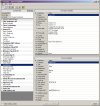Contact registerCMS has its own contact register where name, address, phones, email, web etc. are saved. The information is structured so that all employees of a company share the same company information, and changes in a company then only need to be updated once. Everywhere in CMS where a person name or company name is required, lookup is done towards the contact register and names are suggested as you type. When listing e.g. to/from columns in the doclist, the operator can quickly change between listingmodes "Person - Company" or "Company - Person", and for the person-name change even "Firstname Lastname" or "Lastname, Firstname" listmodes. This way it is easy to scan for documents by either person-name or by company-name, whichever is more convenient.
The contactregister can be synchronized with Outlook or Exchange address books if required. The CMS dataformat is Microsoft Access compatible, so it is easy to use the data with other applications.
|


|